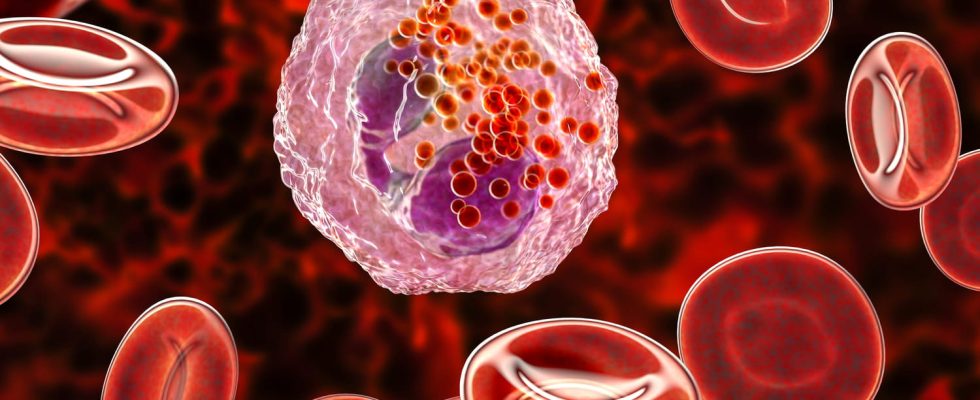White blood cells are mainly divided into three groups: lymphocytes, polymorphonuclear and monocytes. Eosinophils represent a type of polymorphonuclear cells. Why does their rate increase or on the contrary decrease? What are the normal values ?
Definition: what are polymorphonuclear eosinophils?
Polymorphonuclear eosinophils are white blood cells (leukocytes). There are three main types of polymorphonuclear: neutrophils, basophils and eosinophils. Polymorphonuclear neutrophils, the most numerous, rise above all in the event of bacterial infection. They called polymorphonuclear because their nucleus is multilobed. THE eosinophils stain orange with the dyes used for complete blood counts (NFS).
What is the normal level of polymorphonuclear eosinophils?
Eosinophilic polymorphonuclear cells represent 1 to 3% of white blood cells circulating in the blood. Their number varies from 0.04 to 0.4 billion per liter of blood (i.e. 40 to 400 polymorphonuclear eosinophils per mm3 of blood).
High rate of polymorphonuclear eosinophils: what causes?
A high level of eosinophils is called hyper-eosinophilia. It can be observed during a parasitic disease due to the role of eosinophils in immune mechanisms. But it can also turn out to be abnormal and harmful during certain conditions, in particular allergics. The increase in polymorphonuclear eosinophils requires the search for its causes:
- frequently an allergic origin or parasitic affections,
- asthma or chronic obstructive pulmonary disease (COPD),
- of the skin diseases (atopic dermatoses, eczema, chronic pruritus, etc.),
- systemic diseases (connectivity, Churg and Strauss disease, etc.),
- some digestive diseases (Crohn’s disease, ulcerative colitis),
- taking certain medications (antibiotics, antituberculous, antifungal, antiparasitic, psychotropic, anti-epileptic, oral antidiabetic, anti-inflammatory),
- of the cancers or lymphomas, especially in Hodgkin’s disease.
Low polymorphonuclear eosinophils: what causes?
A low eosinophilic polymorphonuclear count does not indicateno abnormalitythis rate sometimes even being 0. A low rate, called eosinopeniais frequent in the event of prolonged corticosteroid therapy, stress, hemodialysis without this constituting a pathological variation.
The rate of polymorphonuclear eosinophils is calculated on the complete blood count (blood test), often on routine check-ups. In a subject with an allergic tendency, it is not uncommon for it to be chronically elevated. When symptoms suggestive of allergies are present, measuring the level of polymorphonuclear eosinophils can guide the diagnosis.
When to consult?
When the very high eosinophil count, in a subject not known for his allergic tendencies, it is useful to consult to rule out a more serious diagnosis. It is also advisable to be cautious when discovering hyper-eosinophilia in pregnant women which can evoke herpes which, in its genital form, can be dangerous for the baby at the time of delivery.
What treatments when you have too many eosinophils?
The treatment of hyper-eosinophilia is that of its cause: management of allergies, anti-parasitic treatments, management of chronic diseases. Eosinophilia levels can be a good marker of disease progression. “Numerous recent studies reveal the interest of the dosage of eosinophils in the adaptation of the treatment of asthma and COPD” concludes Dr Anne-Christine Della Valle, general practitioner.
